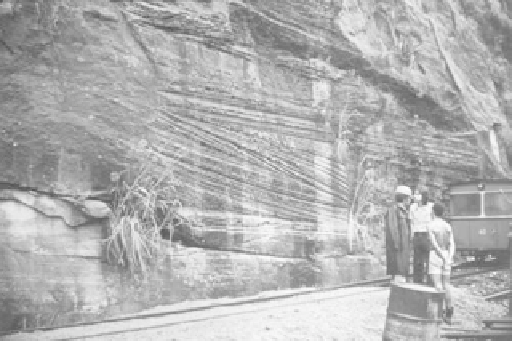Environmental Engineering Reference
In-Depth Information
FIGURE 5.3
Cross-bedding in sandstone (Santa
Amara, Bahia, Brazil).
Cross-bedding
Wave and current action produce cross-bedded stratification as shown in Figure 5.3.
Ripple Marks
Wave and current action can also leave ripple marks on the top of some beds.
Unconformity
An unconformity exists when a stratum is partially removed by erosion and a new stra-
tum is subsequently deposited, providing an abrupt change in material.
Disconformity
A lack of parallelism between beds, or the deposition of a new stratum without the ero-
sion of the underlying stratum after a time gap, results in a disconformity.
Lithification
Rock forms by lithification, which occurs as the thickness of the overlying material
increases. The detritus or precipitate becomes converted into rock by: compacting; the
deposition of cementing agents into pore spaces; and physical and chemical changes in the
constituents. At the greater depths ”consolidation” by cementation is a common process,
caused by the increase in the chemical activity of interstitial water that occurs with the
increase in temperature associated with depth.
Classification
Sedimentary rocks have been divided into two broad groups: detrital and nondetrital. A
general classification is given in
Table 5.8
and more detailed classifications and descrip-
tions in
Tables 5.9
and
5.10.
A special classification system for carbonate rocks formed in
the middle latitudes is given in Table 7.10.
Detrital Group (Clastic Sediments)
Classified by particle size as conglomerate, sandstone, siltstone, and shale. Arenaceous
rocks are predominantly sandy. Argillaceous rocks are predominantly clayey.



